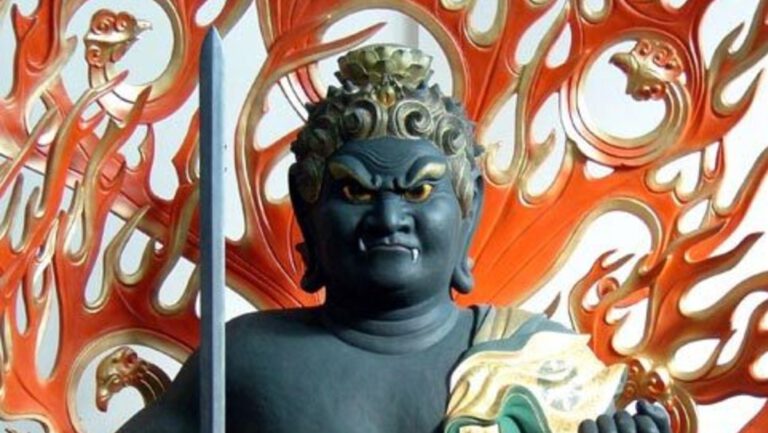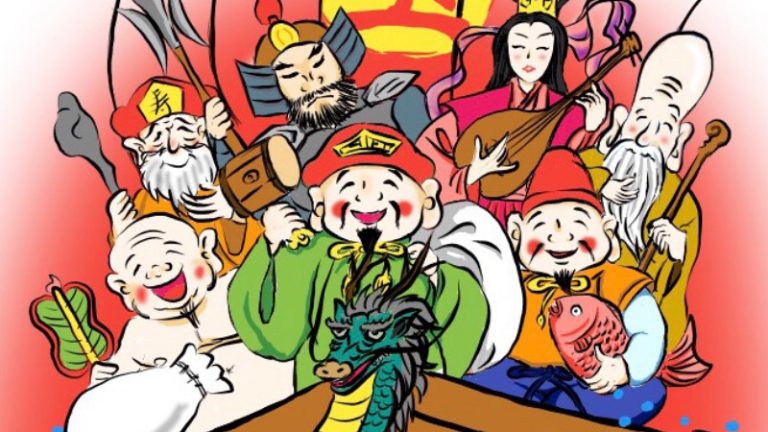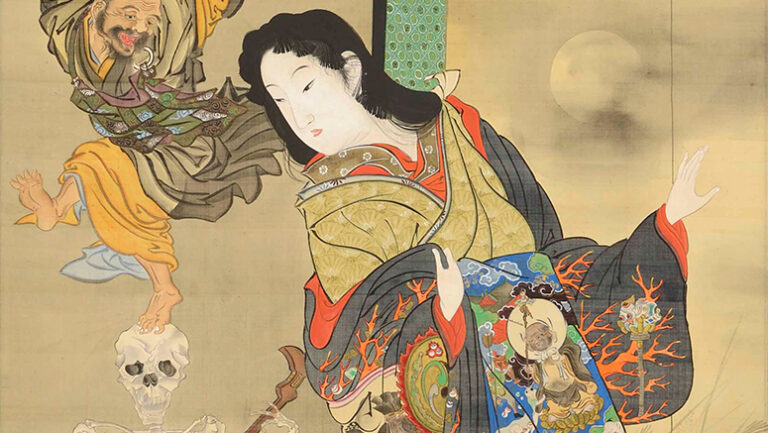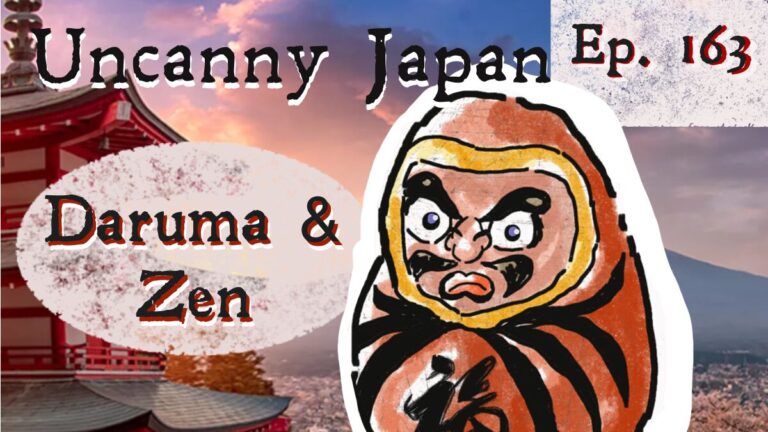Hey, hey, this is Thersa Matsuura and you’re listening to Uncanny Japan.
Remember last episode when we talked about ohaguro, the practice of blackening your teeth to:
1. make yourself more attractive
or 2. maybe it’s you’re coming of age day
or 3. perhaps you want to show your faithfulness to your spouse because black is not only beautiful, but it’s a color that shows loyalty, unable to be dyed by any other color
or 4. possibly coloring those choppers black shows your allegiance to your daimyo, let him know you’ll serve under him and no other lord
or 5. perchance you have bad teeth and want that extra layer of protection that only fermented iron shavings and gallnuts can provide
or finally 6. too far gone, you have a mouth full of cavities that are killing you and you need some decent pain relief.
Well, there were all sorts of good reasons to dye your pearly whites, not so pearly white. But today we’re going to test the theory that Black Teeth were Attractive, because we’re going to talk about a couple yokai who sported this fancy, once upon a time trend, and see how they were received back in the day.
Intro.
The Tsunokakushi Wedding garment
Before I get to the first yokai, I want to introduce you to an article of clothing that I’ve been obsessed with ever since I first heard someone reference it and I had to ask, Does that mean what I think it means? It did. I kind of think I’ve talked about it here before, but for the life of me, I don’t remember where. So. I’m talking about it again. It’s going to segue into our first yokai, so don’t worry. I’m not going on too much of a tangent.
In Japan, if you’re having a traditional Shinto wedding ceremony, the bride will wear a stunning (usually) white silk kimono with a matching headpiece. There are a couple different shapes to this headpiece: one that goes all the way around the head, almost like a wide ribbon and another that looks like a large billowy hood. Either way they’re called tsunokakushi/角隠し
Tsuno is the word for horns and kakushi means to hide. Hiding horns. What? How cool is that? And by cool, I mean horrible. The idea is that the bride should hide her ‘horns’ of jealousy and selfishness and become a nice, polite, obedient wife. When I first heard about the tsunokakushi, I made up a story in my head about men marrying oni women and it was much more exciting than just being a good wife.
Ohaguro-Bettari Yōkai
That tsunokakushi comes to play with our first blackened toothed yokai. She’s called Ohaguro-bettari/お歯黒ベッタリ. We know Black Teeth, ohaguro. And bettari is a great word that has the meaning of something being spread all over something or stuck all over something. It could be something like say you’re dipping your sushi into your soy sauce. Do you dab it lightly and get a little shoyu on your kappa maki? Or do you dunk the whole thing in, swish it around, turn it upside down so it gets soaked in soy sauce. That would be bettari. Which is really rude, so don’t do that.
Another bettari example is you’ve got a very clingy friend who is hanging all over you or a sibling or child. That would be bettari, too.
Anyway, Ohaguro Bettari just means that all her teeth are dyed black, completely, all over, which takes on more meaning when you realize this yokai has a huge mouth. One of those kuchi sake onna mouths, from ear to ear…with all black teeth.
The most iconic image, I think, of the Haguro Bettari was illustrated by Shunsensai Takehara in a work called Ehon Hyaku Monogatari. This came out in the late Edo, 1841. The picture is a woman in a beautiful flowered kimono, crouched down next to what looks like a torii gate. So she’s at a shrine. Her hair is done up and she’s wearing a tsunokakushi around her head, so her wedding attire. She’s looking back over her shoulder and it looks like she’s clapping her hands. But what gets your attention isn’t so much the wide smile with all black teeth, but the fact that she doesn’t have a nose or eyes.
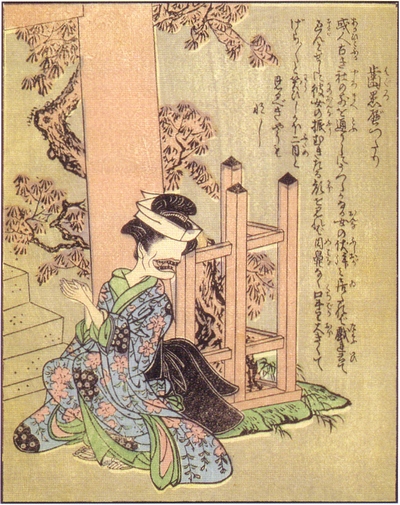
Takehara Sensei was kind enough to add an explanation that goes something like: a man is passing an old shrine when he notices a woman on the ground prostrating herself in what looks like prayer. The man decides to go over and tease her, perhaps give her a fright. But when he does, she turns to face him and starts laughing insanely, Gera Gera Gera! She has no eyes or nose, only one large black toothed mouth. The man runs away and tells everyone that was the scariest thing he’s ever seen.
If that sounds familiar, it is. Have I ever told you about the Nopperabou which is a non-faced yokai whose sole purpose usually is to go around frightening people.
There’s been speculation about this picture. For example, at the time it was made, blackening one’s teeth was still performed mostly by upper class women, like samurai wives or women who followed the Jodo Shinshu Buddhist sect. So why would she be wearing wedding kimono? Some believe this particular Ohaguro Bettari was actually the ghost of a woman who died right before her wedding or on the day of her wedding, so she’s there to haunt the shrine. But why, how? We’ll probably never know, but sounds like a sad story.
Ao Nyobo or Ao Onna
Now there are also some folktales from up north-east in the Tohoku Region about people or mountain ascetics who tease foxes and tanukis and then later have that same animal (or maybe a friend, I don’t know, they kind of all look alike) show up at their door, open their mouths really wide and ask: Do I have black teeth? Which is unsettling, I suppose. But kind of hilarious, too.
Another black-toothed yokai is called Ao Nyobo or Ao Onna, the Blue Lady. She dresses like an upper class woman of the court. Toriyama Sekien depicted her wearing a Heian Era kimono, but in an old run down estate. She’s probably not a higher level court lady, but a somewhat lower ranked one, or works there and dresses nicely. In this piece, she’s sitting, gazing into a mirror with her mouth opened wide, showing off her dark-colored teeth, brush in her left hand. And that’s about it.
Some speculation goes like this: Ao in Japanese means blue or green and can also mean young or immature. An Ao Samurai meant a sixth ranked samurai. Ao Nyobo, because nyobo means wife, meant she was the wife of a sixth ranked samurai. So while dressed in Heian Era garb, not a very high ranking lady.
Sometimes the Ao Nyobo is portrayed as vengeful and haunting old imperial palaces and noble residences, but in other stories she’s more mischievous who just like pranking people.
And finally, let me tell you about the last beastly, black-toothed creature.
Folktale of Uwan from Aomori Prefecture
But here, let me set the mood.
Your name is Kasuke and you live in Aomori Prefecture, Edo Jidai. Recently our go-between introduced you to the most amazing woman. You’re smitten. She’s slightly out of your league, but it turns out there’s something about you, your charm maybe, those roguish good looks? Whatever it is, you learn she’s fond of you, too. Now you have renewed purpose in life. Determined to show your worthiness to both her and her parents, you work real hard and save up enough money to not only marry her, but to buy a house for you both to live in and raise a family.
A house in the country. It’s quite roomy and you’re proud of yourself for getting such an unbelievable deal. Okay, it’s not a new house or even slightly used one. It’s actually quite old, a little run down… a little creaky in places, a little drafty in others, and no matter how many times you ask, everyone is suspiciously vague about its history, and the past residents, who they were, what happened to them, and what’s that strange stain on the tatami floor that just doesn’t come out?
Doesn’t matter. You’re full of Love Hormones and completely optimistic about everything, your life right now and your future with your new wife. You’re newlyweds, right? After moving in, your first day in the house, you unpack a little, explore the many empty somewhat off-smelling rooms, then greet the neighbors. The sinks low in the sky, so return home and light the iori sunken hearth, while your beloved fills an iron pot with chopped daikon, gobo root, miso and some fresh Yama Kujira. That’s Mountain Whale. Wild. boar for those who don’t know. Your first dinner as a married couple.
It starts to get late and time to turn in. You’re both exhausted. It’s been a long day of travel and getting setup in the new house. You climb into your futons, his and hers, situate your wooden pillows under your necks and turn to face each other. A single oil lamp flickers low in the corner of the room. You’re thinking up until right now, this is the happiest moment of your life. You’re thinking, this is absolutely bliss. You’re thinking…
Uwan!
What? Uwan!
What was that? You bride asks, clutching the futon to her neck.
I-i don’t know. You say, a little freaked out yourself. Uwan!
There it is again. Uwan! Okay. This isn’t right.
It’s coming from one of the other rooms, your wife says. From inside the house!
I think you’re right.
Well, aren’t you going to see what it is?
You think how utterly dark it out there in those long halls, many rooms, remember no electricity. It’s a new moon so you don’t even have that going for you. There’s a candle or paper lantern…but
And that’s the moment, when you and your new bride learn, you’re not the strong, brave hero you both thought you were. You mumble something about a leg crap this, probably over exerted yourself unpacking and you’re feeling a little dizzy.
So for the rest of the night, the both of you lie there listening to the obnoxious, baffling, and relentless sound of something bounding through the house yelling, Uwan!
What Does the Uwan Look Like?
Now, if you’d been a more courageous soul and gone out to investigate, you would have found a quite horrifying creature, somewhat human-looking, it’d be naked from the waist up, lumpy all over, bald-headed, pot-bellied, with little tufts of hair sprouting everywhere. It would have to large eyes, a widely grinning mouth showing its teeth, all painted black, and its three-clawed hands would both be raised and waving in the air like it, well, just didn’t care, shouting Uwan! Uwan! All. Night. Long.
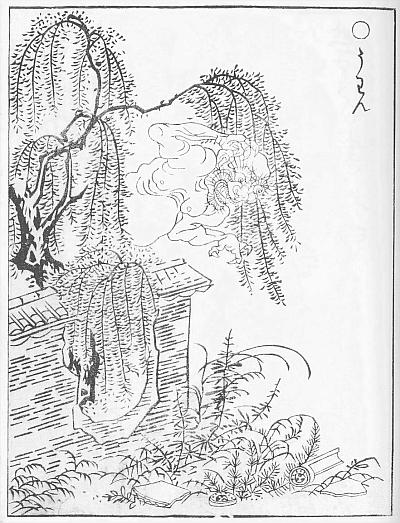
You and your not especially proud of you wife get no sleep at all. The next morning, the insand shouting stops and you both hurry outside to visit your neighbors. Your neighbors see you, tussled hair and bags under your eyes and listen to you complaining about being unable to sleep because of “some yokai creature yelling the entire night”. They exchange glances and say, yeah, right a “yokai”. They didn’t have air quotes back then, but if they did…
But just as they were being dismissive about your serious concerns, along comes and old man who overhears and says, “Ya! Actually, there is a strange creature living in that old house, and that’s what it does: cries out Uwan! the entire night through.”
Yes! You think and look over at your wife. You two aren’t crazy after all.
“What’s this mysterious beast called?” You ask, feeling your bravery return.
“Why, it’s called … the Uwan.”
The end.
At least that’s the way the old folktale that, um, reenactment is based on ends. But here let me give it a better ending.
The old man could have explained there is a way to defeat the Uwan, to scare it away. What’s that, you ask. Well, it’s simply to shout back at it, Uwan! Then it will run away and not return.
So I’m assuming those newlyweds in the original folktale either lived a life in misery with the thing or moved out. Which is a shame. But keep it in mind in case you find yourself in some old inn, or near some old shrine or temple and out jumps an creepy little dude yelling Uwan!
There aren’t a lot of theories about where this yokai came from. Some think maybe it used to someone belonging to an upper class family of nobility or samurai who used to blackened there teeth. But it’s a little non human looking. So something happened along the way. Also three fingers usually signifies and oni. Some maybe some ungodly mixing of the two.
So Are Black Teeth Scary?
Finally, if you remember my original thesis, if you will, was it the black teeth that made these creatures frightening? My opinion is that while it didn’t hurt, it wasn’t the main part of the what made them scary.
Looking at these three yokai, the Ohaguro Bettari, The Ao Onna, and the Uwan, yes, they all have blackened teeth, but it’s not really the main scary point about them. It’s more just to show their rank or who they were in real life, well, for the first two anyway. I’m not sure what’s up with the Uwan. So we can safely assume that teeth blackening wasn’t scary or freaky back in the day. These are three yokai who just happen to have ohaguro.
Thank you for listening, you are all awesome and I’ll talk to you again very soon.

